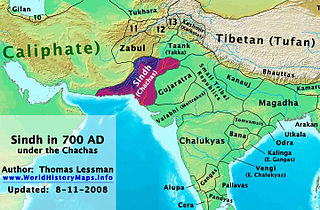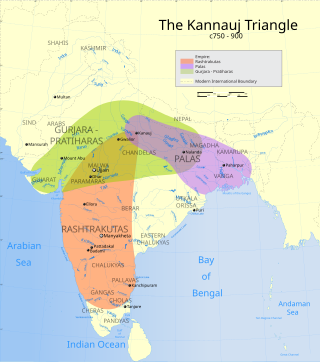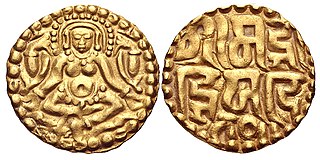Earliest mentions of the terms
The earliest mentions of the terms Gurjara, Pratihara and Gurjara-Pratihara in historical records have been analyzed by scholars to determine the origin of the dynasty.
Pratihara
The Gurjara-Pratiharas as well as the Pratiharas of Mandor used the self-designation "Pratihara". They claimed descent from the legendary hero Lakshmana, who is described as the brother of king Rama in the Sanskrit epic Ramayana . The 837 CE Jodhpur inscription of the Mandor Pratihara ruler Bakuka states that the younger brother of Ramabhadra (Rama) served as a pratihari (door keeper) to his elder brother, because of which his descendants came to be known as Pratihara. The Sagar-Tal (Gwalior) inscription of the Gurjara-Pratihara king Mihira Bhoja says that Saumitri ("son of Sumitra", that is, Lakshmana) acted as a door-keeper for his elder brother as he defeated the enemies in a battle with Meghanada. [3] [4]
K. A. Nilakanta Sastri theorized that the ancestors of the Pratiharas served the Rashtrakutas, and the term "Pratihara" derives from the title of their office in the Rashtrakuta court. [5]
Gurjara

The 6th century Tamil text Manimekalai mentions a temple of "Kucharakudihai" or "Kuchcarakudihai" workmanship. Some scholars interpret this word as the Tamil transliteration of "Gurjara". However, Krishnaswami Aiyangar doubts the accuracy of this interpretation. [6]
The earliest undebatable references to the word "Gurjara" date back to 7th century: [7]
- The word Gurjara occurs in Harshacharita , a Sanskrit work by Bana . The relevant verse describes the military successes of the king Prabhakaravardhana against various kingdoms. It states that the king was a "a lion to the Huna deer, a burning fever to the king of Sindhu, a troubler of the sleep of the Gurjara king, a bilious fever to that scent elephant - the lord of Gandhara, destroyer of the skill of the Latas, an axe to the creeper which is the goddess of fortune of Malava". [8] [6]
- Chinese traveler Xuanzang describes a kingdom named Kiu-che-lo and its capital Pi-lo-mi-lo. These two words have been identified as Chinese transcriptions of "Gurjara" and "Bhillamala" (Bhinmal). This kingdom was located in present-day Rajasthan, surrounded by Mo-la-po (Malwa), U-sha-ye-na (Ujjayini), Po-lu-kie-che-po (Bharukaccha), Fa-la-pi (Vallabhi), and Su-la-ca (Saurashtra). [7]
- The 634 CE Aihole inscription of the Chalukya king Pulakeshin II states that the Gurjaras, the Latas, and the Malavas accepted his suzerainty. According to Puri, the Gurjaras referred to in this record were from Bharukaccha (Bharuch). They are mentioned as "Samanta", and probably owed allegiance to the Kalachuris. [7]
Other early epigraphic evidence includes:
- The 739 CE Navsari copper-plate inscription records the victory of Chalukya feudatory Avanijanashraya Pulakeshin over Tajika (Arab) army. This inscription states that the Tajika army had plundered the Saindhavas, Kachchhelas (Kutch), Saurashtra, Chavotakas, Mauryas, Gurjaras and other kings. [9]
- The Ragholi (Balaghat) copper plates, dated to 8th century on palaeographic grounds, were issued by Jayavardhana II of the obscure Shaila dynasty of central India. It states that his ancestor Prithuvardhana conquered the Gurjara country. [10]
- The 808 CE Radhanpur copper-plates of the Rashtrakuta ruler Govinda III describes his subjugation of several kings. It states that on seeing Govinda, the Gurjara vanished - nobody knows where - and even in a dream he (the Gurjara) might not see another battle. [11] [12] Here, "Gurjara" obviously refers to a particular king. [10]
- The 812 CE Baroda copper-plates of the Rastrakuta feudatory Karka mentions two terms - Gurjareshvara-pati and Gurjareshvara. According to B. N. Puri, both of these refer to one king. [10] According to R. C. Majumdar, this king was Nagabhata II of the Gurjara-Pratihara dynasty. [13] D. C. Ganguly argued that these two referred to two different kings: Gurjareshvara-pati ("overlord of Gurjareshvara") was a king of the imperial Pratihara dynasty, while Gurjareshvara was a subordinate ruler. [14]
- The Arab merchant Sulaiman, in his Silsilat Al Tawarikh (851 CE), mentions Jurz (or Juzr) kingdom. Jurz appears to be a transcription of the word Gurjara, and refers to the kingdom of Kannauj. [15]
- The 866 CE Sirur and Nilgund inscriptions of the Rashtrakuta king Amoghavarsha state that his father Govinda III subjugated the people of Kerala, Malava and Gauda (or Sauta), together with the Gurjaras who resided in the hill fort of Chitrakuta. [16] [17]
- The 867 CE Bharuch grant of Dhruva III mentions that he was attacked by "the very powerful army of the Gurjaras", who had allied with his younger brother. It also states that a king named Mihira attacked Dhruva, but was defeated. According to Georg Bühler and E. Hultzsch, the powerful army here probably refers to that of the Chavada (Chapotaka) king Kshemaraja. [18] However, B. P. Puri believes that the army here refers to that of the Gurjara-Pratihara king Mihira Bhoja. [10]
- The 940 CE Deoli inscription of the Rashtrakuta ruler Krishna III states that his ancestor Krishna II (r. c. 878-914 CE) had frightened the Gurjara, and humbled the Gauda, the Anga, the Kalinga, the Ganga and the Magadha. Here "Gurjara" and others are names of the countries, which signify their kings. [10]
- The Karhad plates of Krishna III state that on hearing about Krishna's conquests in the southern region, the hopes about [retaining] Kalanjara (Kalinjar) and Chitrakuta (Chittor) vanished from the heart of the Gurjara. [19] Here, "the Gurjara" obviously refers to a particular king. [10] This king can only be an Pratihara ruler, as no other dynasty ruled these two forts during this period. [13]
- The Badal Pillar inscription of the Pala ruler Narayanapala (9th-10th century CE) states that he "scattered" the conceit of the Gurjara-natha ("Lord of Gurjara"). Here, Gurjara refers to a country, and the term Gurjara-natha probably refers to the ruler of Kannauj. [20]
- The 954 CE inscription of the Chandela ruler Yashovarman boasts that he subjugated the Gauḍas, the Khasas, the Kosalas, the Kashmiris, the Mithilas, the Malavas, the Chedis, the Kurus, and the Gurjaras. [21] The Gurjaras here refer to the Pratihars of Kannauj. [20]
- The 10th century Kannada work Pampa-Bharata mentions "Gurjara-raja Mahipala", who is identified with the Pratihara king Mahipala. [13]
- The 1047 CE Goharwa inscription of the Kalachuri king Karna-deva states that his ancestor Lakshmana-raja (c. 950 CE) defeated the kings of Vangala, Pandya, Lata, Gurjara and Kashmira. Gurjara here refers to the ruler of Kannauj. [17]
- The 12th century Rajatarangini mentions that the 9th century Kashmiri king Shankara-Varman defeated Alakhana, the king of Gurjara. [17] Some scholars, such as Helmut Humbach and G. Djelani Davary, theorized that "Alakhana" is the Brahmi transcription of the Bactrian word "Alxano", and is related to "Hara Huna" (or Hala Huna) mentioned in ancient Indian texts. [22] However, other scholars identify Alakhana as Ali Khan, a ruler of Gujrat in present-day Pakistan. [23]
Gurjara-Pratihara
The Rajor inscription of a feudatory ruler named Mathanadeva describes him as a Gurjara-Pratihara. [13] According to Puri, he might have been a scion of the Pratihara royal house of Kannauj. [24]





